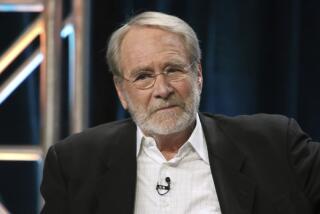Comedy for Art’s Sake
Martin Mull lives other people’s dreams.
Not only is he a successful actor, stand-up comedian and painter, he has also directed a film, and his rock band has released a couple of records.
The Hollywood career has made him famous but, most important, it has paid for the paint, said Mull, who will talk today about his artistic side at the Orange County Museum of Art.
“I would stop acting in a New York second,” Mull said, gesturing toward his paintings in his studio last week. “This is what I take seriously.”
Still, it is sometimes hard for him to be taken seriously as an artist.
“I was immediately considered a dilettante because I was well-known in another area. Show business and fine art do not help each other,” said Mull, who wanted to be a painter since childhood. He got his master’s at the Rhode Island School of Design in 1967.
“I don’t want to be ungrateful,” he said with a smile. “I’m fortunate. I don’t have to drive a taxicab. . . . If I work 11 weeks of the year, I have 41 weeks to paint. It’s pretty good.”
Mull, best-known for his role as Roseanne’s boss on her hit sitcom, “Roseanne,” from 1991 to 1997, has reason to smile.
In his sunlit Brentwood studio, he is surrounded by canvasses, tubes of oil paint, three dogs and a big cat. Downstairs in his 1920s wisteria-covered villa, his wife is reading an algebra text. His 14-year-old daughter is at school.
Giving the Painting a Life of Its Own
Life, indeed, is sweet.
Working in his studio all day, Mull paints, layers, reworks and peels away at the canvasses, trying to uncover “what the painting wants to be.”
At the moment, the paintings want to be figurative childhood memories in ephemeral colors.
Mull, who has gone through many styles--abstract Expressionism, minimalism, conceptual art and photo realism--now paints fragments of an idyllic family life but in chaotic compositions. Running paint underscores mundane scenes, and the paintings seem disquieting and haunting. His “ghosts” and memory fragments focus on suburbia and its discontent.
In pictures such as “We Had Such Hopes,” on display at the Orange County Museum of Art, Mull’s composition is open and unstable, and the paintings’ beauty seems to hint at a sense of loss.
“The first mark on the canvas is difficult,” Mull said. “The next mark is dictated. The sooner you let the painting have its own life, the better.”
And in giving the painting life, Mull would rather be a midwife than a wet nurse.
“Just bring the thing into life and then walk away,” he said, adding that painting scares him more than acting.
“The paintings are your most intense, private moments. To put these intense moments in a situation so public, . . . into a room of black turtlenecks and wine glasses [is daunting]. . . . This is your dirty underwear hanging for God and everybody to see.”
And the paintings are a little frightening too.
“What at first glance seems so positive is a little scary . . . but painting should jolt you a little. The most immediate way to jolt the public is with figurative work. If people can think for a split second that they know what they’re looking at, they trust the picture. . . . [The jolt] is what painting is all about.”
Mull got the inspiration for these pictures as he was leafing through a 1950s school textbook, illustrated with vignettes of happy families and smiling children--images of perfection and the ideal American life anno 1950.
As you learn to read, “you’re being handed all this [nonsense] about perfection,” Mull said. “I take that imagery, deconstruct it and put it back together as chaotic and full of chance.” Images of how things are supposed to be but aren’t.
Glancing at the tranquil garden outside his studio, Mull said:
“The pictures are there because words couldn’t do it.”
* Martin Mull speaks at noon today at the Orange County Museum of Art, 850 San Clemente Drive, Newport Beach. Free. (949) 759-1122.
More to Read
The biggest entertainment stories
Get our big stories about Hollywood, film, television, music, arts, culture and more right in your inbox as soon as they publish.
You may occasionally receive promotional content from the Los Angeles Times.










